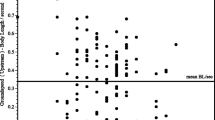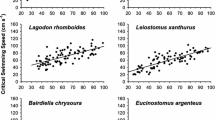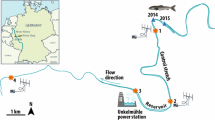Abstract
Upon metamorphosis, anadromous juvenile lamprey (macrophthalmia) exhibit distinct migration behaviors that take them from larval rearing habitats in streams to the open ocean. While poorly studied, lamprey larvae (ammocoetes) also engage in downstream movement to some degree. Like migrating salmon smolts, lamprey macrophthalmia undergo behavioral changes associated with a highly synchronized metamorphosis. Unlike salmon smolts, the timing of juvenile migration in lamprey is protracted and poorly documented. Lamprey macrophthalmia and ammocoetes are not strong swimmers, attaining maximum individual speeds of less than 1 m s−1, and sustained speeds of less than 0.5 m s−1. They are chiefly nocturnal and distribute throughout the water column, but appear to concentrate near the bottom in the thalweg of deep rivers. At dams and irrigation diversions, macrophthalmia can become impinged on screens or entrained in irrigation canals, suffer increased predation, and experience physical injury that may result in direct or delayed mortality. The very structures designed to protect migrating juvenile salmonids can be harmful to juvenile lamprey. Yet at turbine intakes and spillways, lampreys, which have no swim bladder, can withstand changes in pressure and shear stress large enough to injure or kill most teleosts. Lamprey populations are in decline in many parts of the world, with some species designated as species of concern for conservation that merit legally mandated protections. Hence, provisions for safe passage of juvenile lamprey are being considered at dams and water diversions in North America and Europe.








Similar content being viewed by others
References
Applegate VC (1950) Natural history of the sea lamprey Petromyzon marinus in Michigan. United States Department of the Interior, Fish and Wildlife Service Special Scientific Report, Fisheries 55, 237 pp
Applegate VC, Brynildson CL (1952) Downstream movement of recently transformed sea lampreys, Petromyzon marinus, in the Carp Lake River, Michigan. Trans Am Fish Soc 81:275–290
Beamish FWH (1980) Biology of the North American anadromous sea lamprey (Petromyzon marinus). Can J Fish Aquat Sci 37:1924–1943
Beamish RJ, Youson JH (1987) Life history and abundance of young adult Lampetra ayresi in the Fraser River and their possible impacts on salmon and herring stocks in the Strait of Georgia. Can J Fish Aquat Sci 44:525–537
Bracken FSA, Lucas MC (2013) Potential impacts of small-scale hydroelectric power generation on downstream moving lampreys. River Res Appl 29:1073–1081
Clough SJ, Teague N, Webb H (2014) Even finer bar spacing, how low can you go? In: Turnpenny AWH, Horsfield A (eds) International fish screening techniques. WIT Press, Southampton, pp 57–66
Colotello AH, Pflugrath BD, Brown RS, Brauner CJ, Mueller RP, Carlson TJ, Deng ZD, Ahmann ML, Trumbo BA (2012) The effect of rapid and sustained decompression on barotrauma in juvenile brook lamprey and Pacific lamprey: implications for passage at hydroelectric facilities. Fish Res 129–130:17–20
CRITFC (Columbia River Intertribal Fish Commission) (2011) Tribal Pacific Lamprey Restoration Plan. http://www.critfc.org/salmon-culture/columbia-river-salmon/columbia-river-salmon-species/the-pacific-lamprey/lamprey-plan/. December 2011
CSEWC (Committee on the Status of Endangered Wildlife in Canada) (2013) Wildlife species assessment, species at risk public registry. Online interactive database. www.registrelep-sararegistry.gc.ca. December 2013
Dauble DD, Moursund RA, Bleich MD (2006) Swimming behavior of juvenile Pacific lamprey, Lampetra tridentata. Env Biol Fish 75:167–171
Dawson HA, Quintella BR, Almeida PR, Treble AJ, Jolley JC (in press) Ecology of larval and metamorphosing lampreys. In: Docker M (ed) The Biology of lampreys, Springer
Docker MF (2009) A review of the evolution of non-parasitism in lampreys and an update of the paired species concept. In: Brown LR, Chase SD, Mesa MG, Beamish RJ, Moyle PB (eds) Biology, management and conservation of lampreys in North America. American Fisheries Society Symposium 72, Bethesda, MD, pp 71–114
FPC (Fish Passage Center) (2011) FPC lamprey data queries website. http://www.fpc.org/documents/memos/169-11.pdf. November 2011
FPC (Fish Passage Center) (2013) FPC lamprey data queries website. www.fpc.org/lamprey/lamprey_home.html. December 2013
Grabowski SJ (2009) Assessment of potential effects of operation of reclamation facilities on Pacific lamprey in major tributaries of the Columbia River basin. Report to U.S. Bureau of Reclamation, Boise
Hardisty MW, Potter IC (eds) (1971) The biology of lampreys. London, Academic 423 pp
Hayes MC, Rubin SP, Chase DM, Hallock M, Cook-Tabor C, Hays R, Luzier CW, Schaller HA, Moser ML (2013) Distribution of Pacific lamprey Entosphenus tridentatus in watersheds of Puget Sound based on smolt monitoring data. Northwest Sci 87:95–105
Keefer ML, Caudill CC, Peery CA, Moser ML (2013) Context-dependent diel behavior of upstream-migrating anadromous fishes. Environ Biol Fish 96:691–700
Kostow K (2002) Oregon lampreys: natural history, status, and problem analysis. Oregon Department of Fish and Wildlife, Salem, OR, Information Report 02-1
Kucheryavyi AV, Savvaitova KA, Pavlov DS, Gruzdeva MA, Kuzishchin KV, Stanford JA (2007) Variations of life history strategy of the Arctic lamprey Lethenteron camtschaticum from the Utkholok River (Western Kamchatka). J Ichthyol 47:37–52
Lampman RT, Beals TE (2014) A mark-release-recapture study in Congdon Diversion (Naches, WA) to assess dispersal and entrainment of larval/juvenile lamprey. Yakama Nation Fisheries Resource Management Program, Pacific Lamprey Project. Report to Bureau of Reclamation, Boise, ID 28 pp
Lampman RT, Beals TE, Johnson E, Luke P, Lumley D (2014) Assessment of juvenile/larval lamprey entrainment in irrigation diversions and canals within the Yakima River Subbasin. Yakama Nation Fisheries Resource Management Program, Pacific Lamprey Project. Report to Bureau of Reclamation, Boise, ID 61 pp
Long CW (1968) Diurnal movement and vertical distribution of juvenile anadromous fish in turbine intakes. Fish Bull 66:599–609
Lucas MC, Greaves RK, Bubb DH, Kemp PS (2007) Stanley Mills lamprey report no. 256. Scottish Natural Heritage commissioned report. (ROAME No. F04LH03)
Luzier C, Silver G (2005) Evaluate habitat use and population dynamics of lamprey in Cedar Creek. Report of the U.S. Fish and Wildlife Service to the Bonneville Power Administration. www.efw.bpa.gov/IntegratedFWP/technicalreports.aspx. Document ID 00020682-1 (December 2013)
Mesa MG, Weiland LK, Chritiansen, HE (2014) Synthesis of juvenile lamprey migration and passage research and monitoring at Columbia and Snake River dams. Report to U.S. Army Corps of Engineers, Portland District, Portland, OR 64 pp
Maitland PS, Renaud CB, Quintella BR Close DA (in press) Conservation of native lampreys. In: Docker M (ed) The biology of lampreys, Springer
McIlraith BJ (2011) The adult migration, spatial distribution, and spawning behaviors of anadromous Pacific lamprey (Lampetra tridentata) in the lower Snake River. Unpublished MS thesis, University of Idaho, Moscow, ID
Moser ML, Close DA (2003) Assessing Pacific lamprey status in the Columbia River Basin. Northwest Sci 77:116–125
Moser ML, Russon IJ (2009) Development of a separator for juvenile lamprey 2007–2008. Report to the U.S. Army Corps of Engineers, Walla Walla District, Walla Walla, Washington
Moser ML, Vowles AS (2010) Development of a separator for juvenile lamprey 2008–2009. Report to the U.S. Army Corps of Engineers, Walla Walla District, Walla Walla, Washington
Moser ML, Butzerin JM, Dey D (2007) Capture and collection of lampreys: the state of the science. Rev Fish Biol Fish 17:45–56
Moursund RA, Dauble DD, Bleich MD (2000) Effects of John Day Dam bypass screens and project operations on the behavior and survival of juvenile Pacific lamprey (Lampetra tridentata). Report to the U.S. Army Corps of Engineers Portland District, Portland, Oregon 25 pp
Moursund RA, Mueller RP, Degerman TM Dauble DD (2001) Effects of dam passage on juvenile Pacific lamprey (Lampetra tridentata). Report to the U.S. Army Corps of Engineers, Portland District, Portland, Oregon 30 pp
Moursund RA, Mueller RP, Ham KD, Degerman TM, Vucelick ME (2002) Evaluation of the effects of extended length submerged bar screens at McNary Dam on migrating juvenile lamprey (Lampetra tridentata). Report to the for U.S. Army Corps of Engineers, Portland District, Portland, Oregon 31 pp
Moursund RA, Bleich MD, Ham KD, Mueller RP (2003a) Evaluation of the effects of extended length submerged bar screens on migrating juvenile lamprey (Lampetra tridentata) at John Day Dam in 2002. Report to the for U.S. Army Corps of Engineers, Portland District, Portland, Oregon 29 pp
Moursund RA, Dauble DD, Langeslay MJ (2003b) Turbine intake diversion screens: investigating effects on Pacific lamprey. Hydro Rev 22:40–46
Mueller RP, Moursund RA, Bleich MD (2006) Tagging juvenile Pacific lamprey with Passive Integrated Transponders: methodology, short-term mortality, and influence on swimming performance. N Am J Fish Mgmt 26:361–366
Murdoch SP, Beamish FHW, Docker MF (1991) Laboratory study of growth and interspecific competition in larval lampreys. Trans Am Fish 120:653–656
Neitzel D, Dauble DD, Cada G, Richmond M, Guensch G, Mueller RP, Abernethy CS (2004) Survival estimates for juvenile fish subjected to a laboratory-generated shear environment. Trans Am Fish Soc 133:447–454
Potter IC (1970) The life cycles and ecology of Australian lampreys of the genus Mordacia. J Zool 161:487–511
Potter IC (1980) Ecology of larval and metamorphosing lampreys. Can J Fish Aquat Sci 37:1641–1657
Potter IC, Huggins RJ (1973) Observations on the morphology, behaviour and salinity tolerance of downstream migrating river lampreys (Lampetra fluviatilis). J Zool 169:365–379
Quintella BR, Andrade NO, Esphanhol R, Almeida PR (2005) The use of PIT telemetry to study movements of ammocoetes and metamorphosing sea lampreys in river beds. J Fish Biol 66:97–106
Renaud CB (1997) Conservation status of Northern Hemisphere lampreys (Petromyzontidae). J App Ich. 13:143–148
Riley WD, Maxwell DL, Ives MJ, Bendall B (2011) Some observations on the impact of temperature and low flow on the onset of downstream movement of wild Atlantic salmon, Salmo salar L., smolts. Aquaculture 262–3:216–223
Robinson TC, Bayer JM (2005) Upstream migration of Pacific lampreys in the John Day River, Oregon: behavior, timing, and habitat use. Northwest Sci 79:106–119
Rose BP, Mesa MG (2012) Effectiveness of common fish screen materials to protect lamprey ammocoetes. N Am J Fish Manag 32:597–603
Rose BP, Mesa MG, Barbin-Zydlewski G (2008) Field-based evaluations of horizontal flatplate fish screens. N Am J Fish Manag 28:1702–1713
Silva S, Gooderham A, Forty M, Morland B, Lucas MC (in press) Egg drift and hatching success in European river lamprey Lampetra fluviatilis: is egg deposition in gravel vital to spawning success? Aquat Conserv
Sutphin ZA, Hueth CD (2010) Swimming performance of larval Pacific lamprey (Lampetra tridentata). Northwest Sci 84:196–200
Teague N, Clough SJ (2014) The survival of lamprey on travelling screens at potable water intakes. In: Turnpenny AWH, Horsfield A (eds) International fish screening techniques. WIT Press, Southampton, p 101
Turnpenny AWH, O’Keeffe NJ (2005) Screening for intake and outfalls: A best practice guide. Science report SC030231, Environment Agency, Bristol, UK
Ullén F, Deliagina TG, Orlovsky GN, Grillner S (1997) Visual pathways for postural control and negative phototaxis in lamprey. J Neurophysiol 78:960–976
USFWS (U.S. Fish and Wildlife Service) (2013) Fisheries resources: Pacific lamprey conservation initiative website. www.fws.gov/pacific/Fisheries/sphabcon/Lamprey/index.cfm. December 2013
Acknowledgments
This review benefitted from help and data provided by the following researchers: M. Docker, M. Gessel, M. Hayes, J. Jolley, P. Kemp, R. Lampman, R. Mensik, M. Mesa, I. Russon, J. Simonson, B. Spurgeon, S. Tackley, B. Trealoar, A. Vowles, J. Weaskus, L. Weitcamp, and J. Wolf. Anonymous reviewers provided valuable comments on an early draft that were incorporated into this version. This work was funded in part by the U.S. Army Corps of Engineers, and the Bonneville Power Administration.
Author information
Authors and Affiliations
Corresponding author
Rights and permissions
About this article
Cite this article
Moser, M.L., Jackson, A.D., Lucas, M.C. et al. Behavior and potential threats to survival of migrating lamprey ammocoetes and macrophthalmia. Rev Fish Biol Fisheries 25, 103–116 (2015). https://doi.org/10.1007/s11160-014-9372-8
Received:
Accepted:
Published:
Issue Date:
DOI: https://doi.org/10.1007/s11160-014-9372-8




